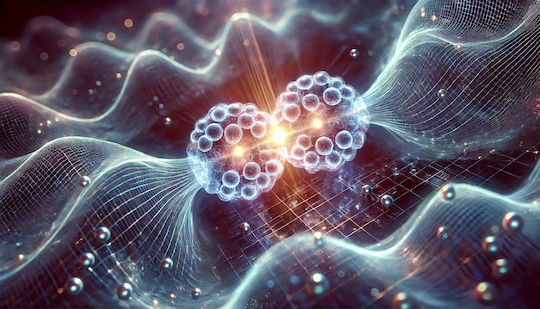
The Majorana Code: Microsoft’s Weirdest Bet Yet
Posted February 28, 2025
Chris Campbell
Behold the chip.
Stare at it. Admire its intricate, alien beauty.
Allow yourself to be fully mesmerized by its strange, golden glow. Its delicate, whispery features.
Its undeniable aura of I am very, very expensive.

Yes, this is Microsoft’s Majorana 1, the latest quantum processor.
It looks cool. Everyone says it is cool.
Scientists are nodding sagely. Tech journalists are using words like breakthrough and paradigm shift. Somewhere, a billionaire is probably gesturing at it meaningfully.
But…
Is this one of those things where everyone claps politely, cheers enthusiastically, and very few understand what it does?
Yes.
But, don’t worry.
Stick with me until the end and you’ll know way more than the average tech reporter. (It’ll be worth it for the next dinner party.)
The Dark Quantum Horse
The headlines are flashy.
And why wouldn’t they be?
CEO Satya Nadella says they’ve “created an entirely new state of matter.”
Krysta Svore from Microsoft's quantum team says they can not only observe this new state of matter but also manipulate and bend it to their will.
Quantum cybersecurity company QuSecure called it the “dark horse the quantum community has been rooting for” and “one of the biggest quantum breakthroughs of the decade.”
Sounds impressive, right? Like something out of a sci-fi movie. It’s enough to give a tech investor the tingles.
BUT, before you rush out and put your kid’s college fund in Microsoft stock…
There are things you need to know.
So let’s break this down without the jargon.
First, the basics.
The Jargon-Free Explanation
Quantum computing is a weird way of computing that can (theoretically) solve problems regular computers struggle with.
Things like simulating molecules for drug discovery or cracking encryption codes.
But it’s not going to replace your kid’s gaming PC or your work laptop. (Unless you and your kids live in an MRI machine at near absolute zero temperature.)
Microsoft is making waves because this chip might fix quantum computing’s biggest headache: error correction.
In traditional quantum computing, information is stored in qubits—tiny, delicate things that make Bubble Boy look like a rugby player.
For clarity, a qubit can be a particle like a photon (PsiQuantum), an electric loop (IBM, Google), an ion (IonQ), or trapped inside silicon (Intel).
Basically anything that can stably exist in quantum superposition can be a qubit.
What is superposition? It’s a fancy way of saying they can be both 0 and 1 at the same time, but only as long as nobody sneezes near them.
Unfortunately, Earth is a sneezy place.
Cosmic rays, static, stray electromagnetic fields, a whiff of heat— even the slightest disturbance can scramble the qubit’s delicate states, leading to errors.
This makes it difficult for them to maintain stable computations.
Enter our new friends: Majorana particles.
These tricky little things—which, by the way, might not even exist (more on that in a moment)—are much harder to destroy when handling computations.
Instead of storing information inside fragile qubits, like a normal quantum computer, Majorana qubits cheat.
Here’s the weird part.
How They Cheat (Yes, The Weird Part)
In the particle world, everything has an opposite. Electrons have positrons, protons have antiprotons—each a mirror twin with an opposite charge.
When these pairs meet, they annihilate each other in a blast of high-energy light waves. (Sometimes, they can create new particles before turning into light. That’s the idea behind the Hadron Collider.)
If you’ve ever gotten a PET scan at a hospital, you’ve experienced this firsthand.
In a PET scan, a radioactive molecule emits positrons (+) that collide with electrons (-), releasing light rays. Detectors capture these rays to create detailed images.
 Source: Sanko, CC BY-SA 3.0
Source: Sanko, CC BY-SA 3.0
But Majorana particles are different.
Instead of having an opposite twin, they are their own twin. It is both itself and its own antimatter counterpart.
In impractical terms, it’s like arguing with your reflection and somehow always losing and winning at the same time.
In practical terms, this means they are electrically neutral and don’t cancel one another out.
Unlike other qubits, Majorana qubits spread their quantum state—where quantum information is processed—across multiple points.
In this way, quantum information isn’t stored in a single location but is encoded in the relationships between pairs of Majorana particles. This “nonlocal” storage makes the system far more resistant to errors.
When you hear about “zero modes,” that’s what the quantum nerds mean—the spaces in between. This is where the Majorana quantum computing happens.
Unlike traditional quantum computing, where information is tied to a single qubit, the information exists in the connections, thus helping to shape the system. In doing so, it becomes an essential part of the system’s overall structure (or “topology”).
One useful analogy is the testudo (“tortoise”) shield formation once used by Roman warriors. If a qubit is a single soldier, a Majorana qubit structure is a testudo, where each soldier’s shield protects not just himself but those around him.
Like the testudo, it’s not just a matter of adding more Majorana qubits; it’s about how they are arranged and protected by the system’s structure.
 Justus Lipsius (1547-1606), Public domain, via Wikimedia Commons
Justus Lipsius (1547-1606), Public domain, via Wikimedia Commons
The noise would have to be strong enough to break the entire system, which is way more difficult than breaking a qubit (or a single Roman).
But There Are Problems
The problems with this approach?
One, we don’t know if these particles exist.
Microsoft claims to have engineered something that behaves like a Majorana particle, but they haven’t directly proven its existence.
Physicists note that while Microsoft’s measurements show a high likelihood of topological (structural) activity, the evidence is not definitive.
Past claims of Majorana discoveries (including one from Microsoft-backed researchers in 2018) have been retracted due to errors.
Two, if they do exist, we don’t know if they’ll scale.
Even if Microsoft has created these quasi-particles, making a few work in a lab is very different from scaling them up into a useful quantum computer.
Their current system only has 8 qubits (and only 7 work)—far from the millions needed for a practical quantum computer.
THAT SAID, if they scale, they could require far fewer physical units to reach the same level of stability. (Because they are, by design, self-protecting.)
Three, if they do scale, we don’t know if they truly are stable atscale.
Other quantum computing approaches are already improving stability through less theoretical methods.
Counter: They could be even more stable.
Four, the process of making them is insanely difficult.
Microsoft had to manually arrange atoms to create their Majorana-based system, which means this is far from an easy-to-manufacture process.
Even if this works at a small scale, mass-producing it could be a nightmare compared to other quantum computing approaches.
Finally, even if Microsoft is onto something, focusing too much on this could put them way behind.
IBM, Google, and others already have functioning quantum computers producing research results. If Microsoft’s method takes too long to prove itself, it might be irrelevant by the time it’s practical.
Brass tacks…
Even if Microsoft has Majorana particles, there are huge hurdles before this technology becomes useful. Right now, it’s more theoretical than proven science.
Majorana is cool. It might change everything. But, right now, there’s still a lot of uncertainty.
